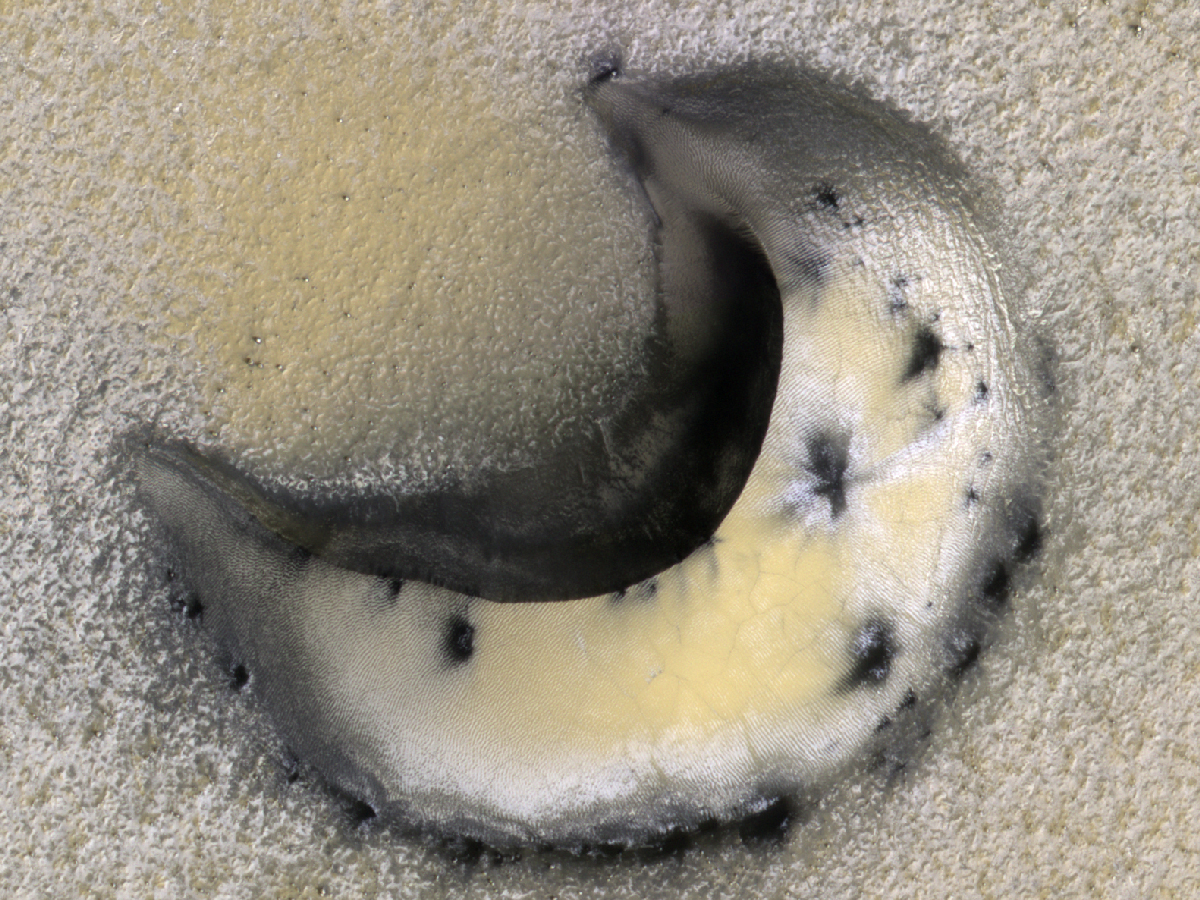Wintery dune

Growth of ripples over time… a long time.
December 23, 2013
Bearded hills
January 8, 2014 A piece of Mars: A single dune sits on the surface of Mars, not too far from the north pole. It’s early spring, but this far north the dune is still covered in white CO2 frost (as well as a thin yellow layer of airfall dust). But the sun has done some work already: the dark spots are areas where enough frost is gone from the warm sun’s rays, revealing the lovely black sand beneath. Before long the frost will be gone and the dark dune will be fully released from its wintery blanket. (HiRISE ESP_033729_2565, NASA/JPL/Univ. of Arizona)
A piece of Mars: A single dune sits on the surface of Mars, not too far from the north pole. It’s early spring, but this far north the dune is still covered in white CO2 frost (as well as a thin yellow layer of airfall dust). But the sun has done some work already: the dark spots are areas where enough frost is gone from the warm sun’s rays, revealing the lovely black sand beneath. Before long the frost will be gone and the dark dune will be fully released from its wintery blanket. (HiRISE ESP_033729_2565, NASA/JPL/Univ. of Arizona)
Update: See my post on July 22, 2014 showing a summertime version of this same dune.




10 Comments
Whose fingerprints are on the “dune”? And a further out/panoramic view would remove the skin look of the terrain.
Those fingerprints are ripples sitting on the dune. Much like the ones you see when you walk on undisturbed sand on the beach, or if you’ve ever walked on a dune freshly resurfaced by the wind. Except the ones on Mars are 2 m apart, whereas the ones on Earth tend to be only a few cm apart.
hi…. this pic is so out of mind
Can you tell me what confuses you?
A fascinating photo and great description – but how big is this thing? It’s impossible to gauge the size of it without a reference – could you maybe add a dimension line, or indicate the distance from apparent dune tip to dune tip?
Yep, I don’t usually list the dimensions of the images (which takes extra time to do, but maybe I should anyway). My bad. This frame is 789×592 m, so the dune is about half a kilometer from one end to the other. That’s pretty big, but isolated dunes like this one are generally on the small side (see the whole image here: http://www.uahirise.org/ESP_033729_2565).
Some of these dark spots are not showing the underlying dune sand directly, but only sand deposits that were deposited by CO2 gas jets on top of the CO2 ice layer. The beautiful multi-axes fan with the white halo is a prime example of that. The only area where it is increasingly likely that the CO2 ice is gone is at the interface between windward dune side and flat ground, where one can see a ring-like appearance of black spots.The Ls value of 32 degrees also definitely allows to have CO2 ice left on the dune at this time.
Yep, that’s all true. I try to keep my captions short, so I didn’t go into detail. I’ve always wanted to do a multi-year study on how those wind streaks appear and what they say about wind directions during springtime.
That’s currently a pending MDAP proposal of Anya and me awaiting selection (hopefully) 😉
Cool! Then I guess I won’t be doing it after all. Good luck!